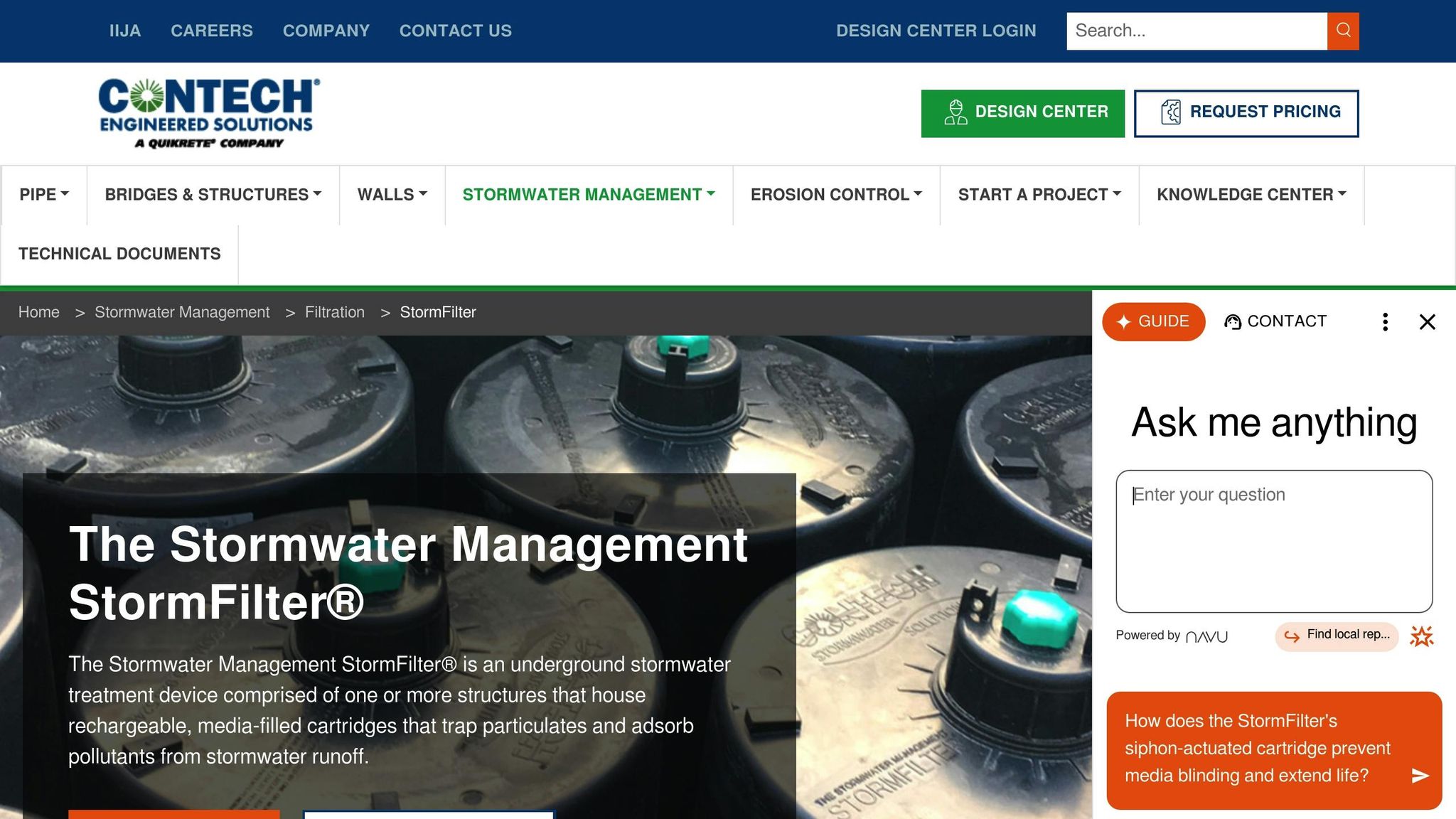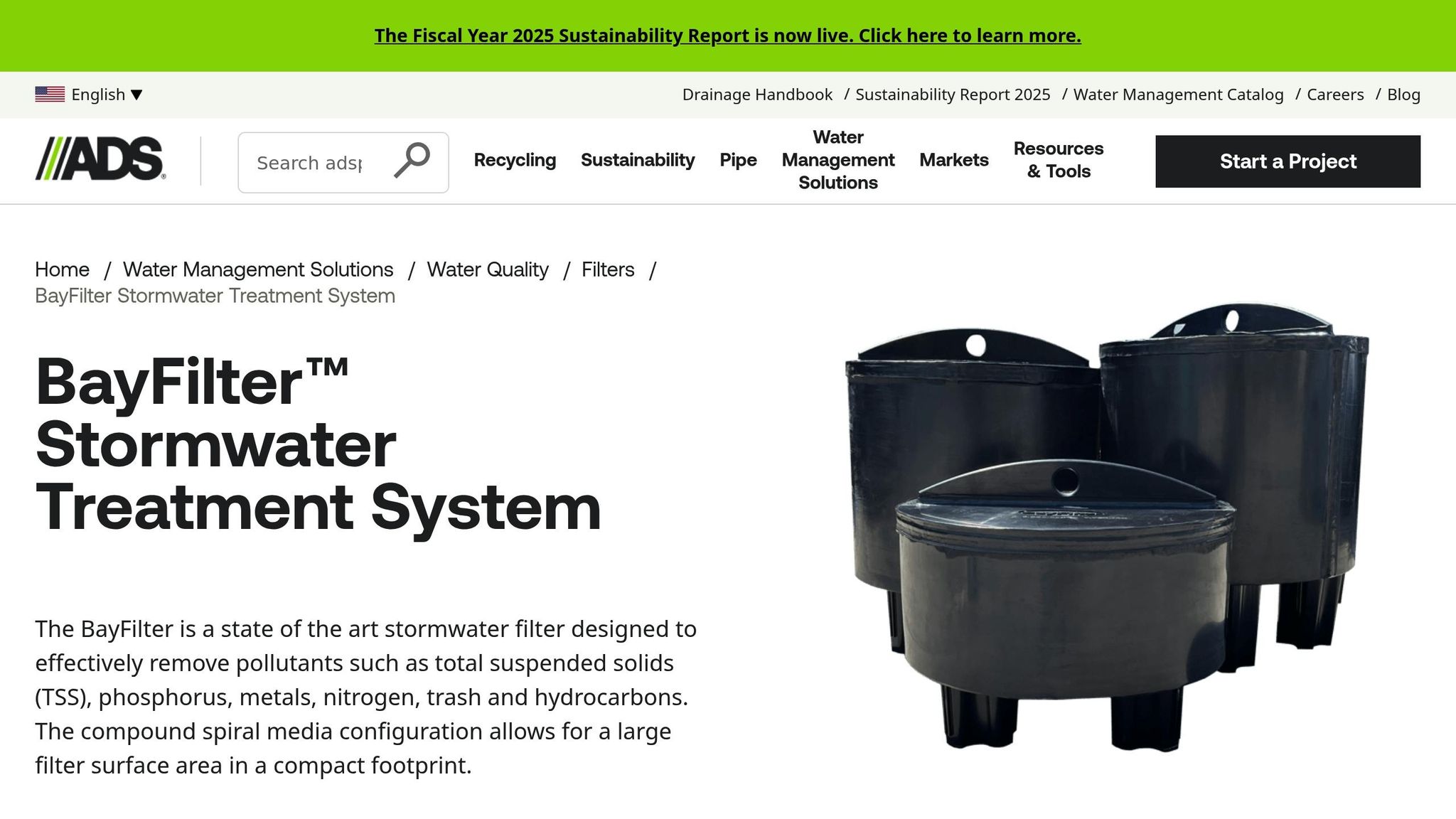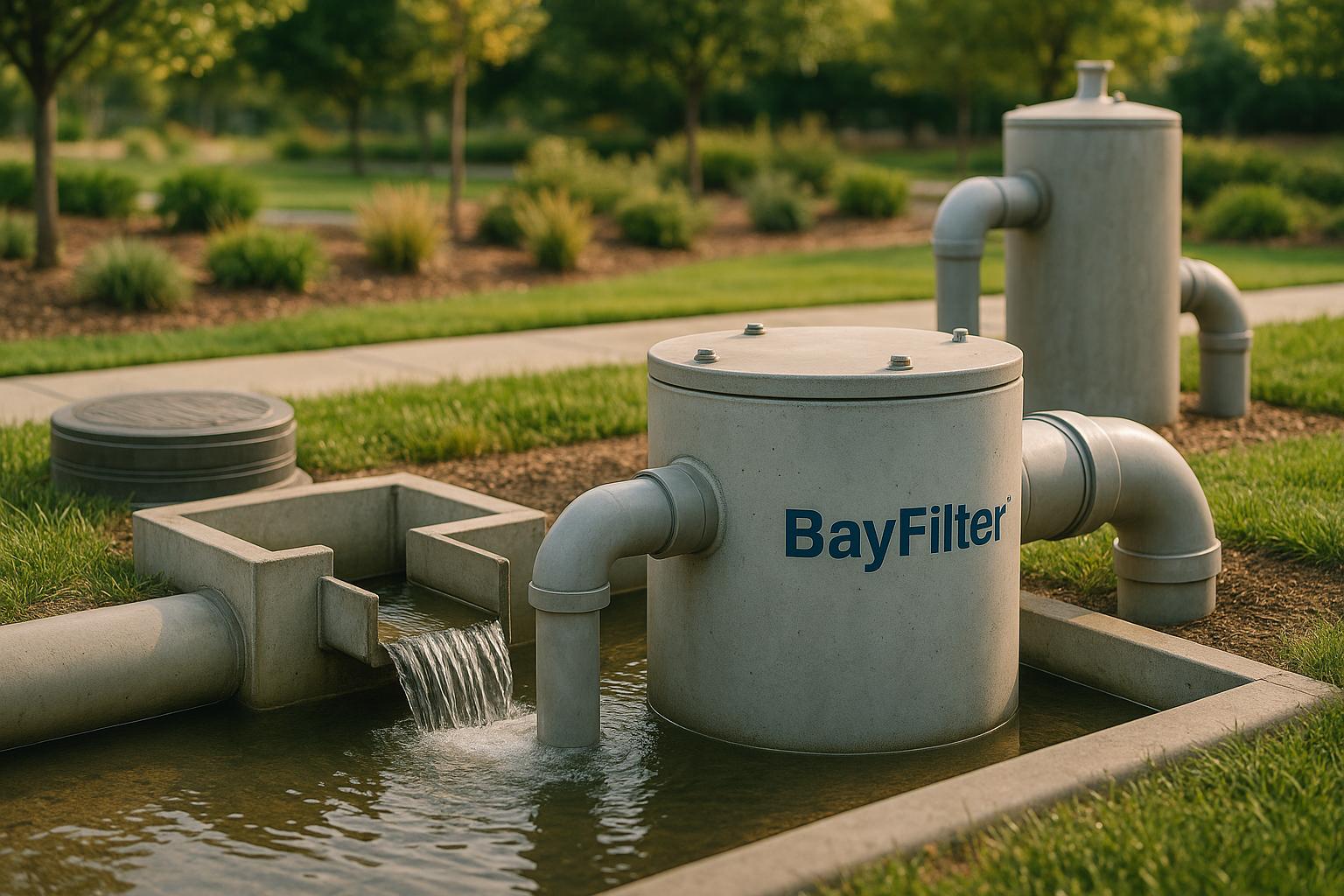- bhavya gada
- No Comments
Choosing the right stormwater filtration system matters. If you’re in Maryland, managing runoff isn’t just about meeting legal requirements – it’s about protecting waterways like the Chesapeake Bay. Two main options stand out: the BayFilter system and other proprietary filtration systems. Here’s how they compare:
- BayFilter System: Focuses on outdoor use, uses a gravity-driven design, and requires minimal maintenance. It’s cost-effective over time and handles sediment loads with modular cartridge options.
- Other Systems: Often designed for indoor use, requiring electrical power, complex setups, and more frequent professional maintenance. Initial costs can be higher, and scaling up may demand complete system upgrades.
Key Takeaway: BayFilter is simpler, more affordable, and better suited for outdoor stormwater management, while other systems are more complex and tailored for indoor water treatment. Your choice depends on your property’s needs, flow rates, and maintenance preferences.
Quick Comparison
| Criteria | BayFilter System | Other Proprietary Systems |
|---|---|---|
| TSS Removal Efficiency | 80.5–87% | 70–90% (varies by system) |
| Power Requirements | None (gravity-driven) | Requires electrical power |
| Installation Complexity | Simple, outdoor placement | Complex setup |
| Maintenance Frequency | Low | Moderate to high |
| Installation Costs | Lower | Higher |
For Maryland property owners facing strict stormwater regulations, BayFilter offers a practical and cost-efficient solution to reduce pollutants while keeping maintenance manageable.
How the Stormwater Management StormFilter Works

1. BayFilter System

The BayFilter system is designed to capture pollutants effectively while minimizing the need for frequent maintenance.
Performance
This system is built to remove pollutants efficiently over extended periods [2]. Its hydrodynamic backwash mechanism ensures consistent performance by preventing the buildup and re-suspension of sediments, oils, and debris between cycles [3]. Additionally, it includes safeguards to avoid toxic or anaerobic conditions during dry spells [1][3]. These features not only enhance performance but also help reduce operating costs.
Cost
Compared to traditional filtration methods, the BayFilter system is more cost-efficient over its lifespan [1][3]. Its design reduces the frequency of maintenance, leading to lower overall expenses. On top of that, the system is straightforward to maintain, which adds to its cost-effectiveness.
Maintenance
Thanks to its self-cleaning design, the BayFilter system requires minimal maintenance [3]. An optional drain-down cartridge can eliminate standing water between storms, helping to prevent mosquito breeding and unpleasant odors [1][3]. When maintenance is necessary, tasks like inspections and cartridge replacements are quick and easy, requiring no specialized tools. This streamlined process minimizes disruptions and keeps long-term service costs manageable.
2. Other Proprietary Filtration Systems
While the BayFilter system focuses on outdoor, low-maintenance use, many other filtration systems are designed for indoor installation and come with specific requirements. These whole-house systems are typically placed indoors near the main water entry point to treat all incoming water[5][7]. The location must be dry, stable, and easily accessible for maintenance, while also being protected from extreme temperatures and direct sunlight[5][6][7]. These conditions are critical for proper setup and long-term functionality.
Before installation, certain parameters must be met. These systems operate within a water pressure range of 29–87 PSI and a temperature range of 39–86°F[6]. Additionally, pre-filtration is necessary to remove particles smaller than 100 microns, achieved using an extra cartridge or a backwash filter[6].
Compatibility with the system also depends on additional factors. For example, systems with automatic control valves need a 230V, 50Hz power outlet located within 10–15 feet of the tank. Installation costs for this setup typically range from $150 to $350[4][6]. Moreover, a 3/4" or 1" drain line must connect to a non-pressurized sewer pipe for proper drainage[6].
sbb-itb-843f8be
Advantages and Disadvantages
When it comes to stormwater management, understanding the pros and cons of different filtration systems is essential for property owners. Each system has its own strengths and limitations, which impact performance, cost, and scalability. Here’s a closer look at how these systems compare.
The BayFilter system operates using a gravity-driven design, which eliminates the need for electrical power or mechanical components. This simplicity not only reduces operational costs but also minimizes maintenance demands. Its modular structure allows for cartridge-based expansion, making it adaptable to various needs[9].
On the other hand, other proprietary filtration systems often involve more complex setups. These systems typically require electrical power and professional servicing, which can significantly increase both installation and maintenance costs. While they can achieve total suspended solids (TSS) removal rates between 70–90%, their performance often depends on the specific design and the quality of ongoing maintenance.
Cost is another key factor that sets these systems apart. BayFilter’s straightforward design means lower upfront installation and maintenance expenses. However, for high-flow applications, multiple cartridges may be necessary, which could raise initial costs for larger properties. In contrast, many other proprietary systems come with higher initial costs and additional service fees over time.
Maintenance needs further highlight the differences. BayFilter systems require only periodic cartridge replacements once the 350-pound sediment capacity is reached[10]. Meanwhile, other systems often demand more intensive professional servicing, especially due to their reliance on mechanical components and electrical systems.
| Criteria | BayFilter System | Other Proprietary Systems |
|---|---|---|
| TSS Removal Efficiency | 80.5–87% | 70–90% (varies by system) |
| Power Requirements | None (gravity-driven) | Requires electrical power |
| Installation Complexity | Simple, outdoor placement | Complex installation |
| Maintenance Frequency | Low (periodic cartridge replacement) | Moderate to high (professional service required) |
| Flow Rate Flexibility | High (modular scaling) | Limited by system design |
| Installation Costs | Lower | Higher |
| Sediment Capacity | 350 lbs per cartridge | Varies significantly |
Beyond these general differences, the BayFilter system offers additional advantages. With a flow rate capacity of 0.33–0.50 gallons per minute per square foot[10], it is well-suited for a wide range of applications. It also removes approximately 95% of particles larger than 5 microns[8], which is particularly beneficial for preserving water quality in landscaping and hardscaping projects.
Scalability is another area where BayFilter excels. Its modular design allows for easy expansion by adding more cartridges. However, for properties with extremely high flow rates, bypass structures may still be needed. By contrast, many other proprietary systems require complete system upgrades to increase treatment capacity, leading to significantly higher costs.
Ultimately, these differences in performance, cost, and scalability are crucial for long-term satisfaction and budgeting. The best choice depends on the specific needs of the property, including flow rates, site conditions, and maintenance preferences.
Conclusion
For Maryland property owners, BayFilter offers a reliable solution for removing total suspended solids, thanks to its gravity-driven design. This approach not only simplifies the process but also helps reduce both installation and maintenance costs.
The system’s modular design makes it versatile, accommodating a range of property sizes and sediment loads by adding or adjusting cartridges. Whether it’s a residential neighborhood or a bustling commercial property, BayFilter adapts seamlessly to meet the needs of central Maryland’s diverse landscapes.
In areas like Howard, Montgomery, and Baltimore Counties, where stormwater regulations are continuously evolving, choosing the right filtration system is crucial. BayFilter effectively removes larger particles, safeguarding water quality in landscaping and hardscaping projects while meeting Maryland’s rigorous stormwater management standards.
Maryland’s unpredictable weather – marked by heavy spring rains and freeze-thaw cycles – demands a filtration system that can handle tough conditions. BayFilter’s simple yet durable design rises to the challenge, making it especially useful for properties with extensive hardscaping such as patios, retaining walls, and drainage systems.
To ensure seamless integration of these systems, Pro Landscapes MD offers expert installation and drainage services across central Maryland. Their extensive experience with stormwater management solutions – including French drains, grading, and land leveling – ensures that your filtration system works harmoniously with your existing landscape. Serving communities from Annapolis to Damascus, they can customize an approach that suits your property’s unique requirements.
BayFilter systems combine efficiency, affordability, and dependability, making them a smart choice for managing stormwater in Maryland.
FAQs
What makes the BayFilter system a great choice for stormwater management in Maryland?
The BayFilter system is recognized for its effectiveness in enhancing water quality, capable of eliminating more than 80% of suspended solids and 65% of phosphorus. This performance makes it a strong option for addressing stormwater challenges across Maryland’s varied environments.
What’s more, it’s designed for simple installation and upkeep. With customizable features and recyclable cartridges, it helps reduce long-term expenses. Its gravity-driven, self-regulating flow design ensures dependable operation while requiring minimal maintenance, offering a practical solution for stormwater management needs.
How do the maintenance needs of the BayFilter system compare to other filtration systems?
The BayFilter system needs regular upkeep, starting with inspections every six months after it’s installed. If you notice a drop in flow rates below the expected design levels, you might need to check the system more often. Maintenance usually includes swapping out filter cartridges, which is a standard task for many proprietary filtration systems.
In general, the BayFilter system’s maintenance routine aligns with other filtration technologies, emphasizing consistent inspections and component replacements to ensure it operates efficiently.
When might a property owner choose a more advanced filtration system instead of the BayFilter system?
When stricter water quality requirements come into play – like removing fine sediments, heavy metals, or phosphorus – property owners might opt for a more advanced filtration system instead of the BayFilter. This is especially true in regions with rigorous environmental regulations or in areas considered environmentally sensitive.
Advanced systems are also a go-to choice when existing infrastructure is already set up to accommodate them or when achieving a higher level of stormwater treatment is critical to meet local standards. Ultimately, the decision often boils down to finding the right balance between performance, maintenance simplicity, and overall cost.


















Chat with Us